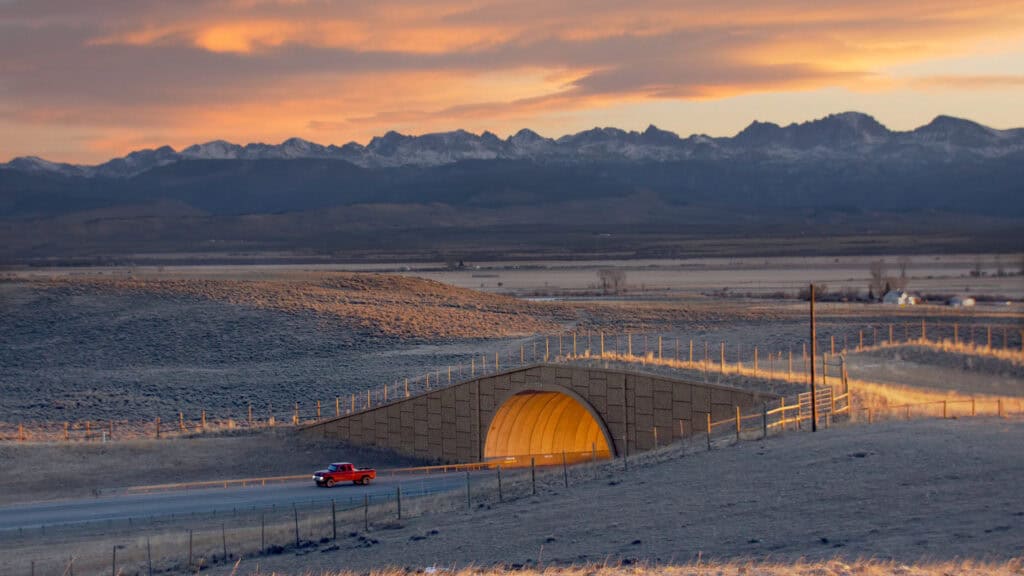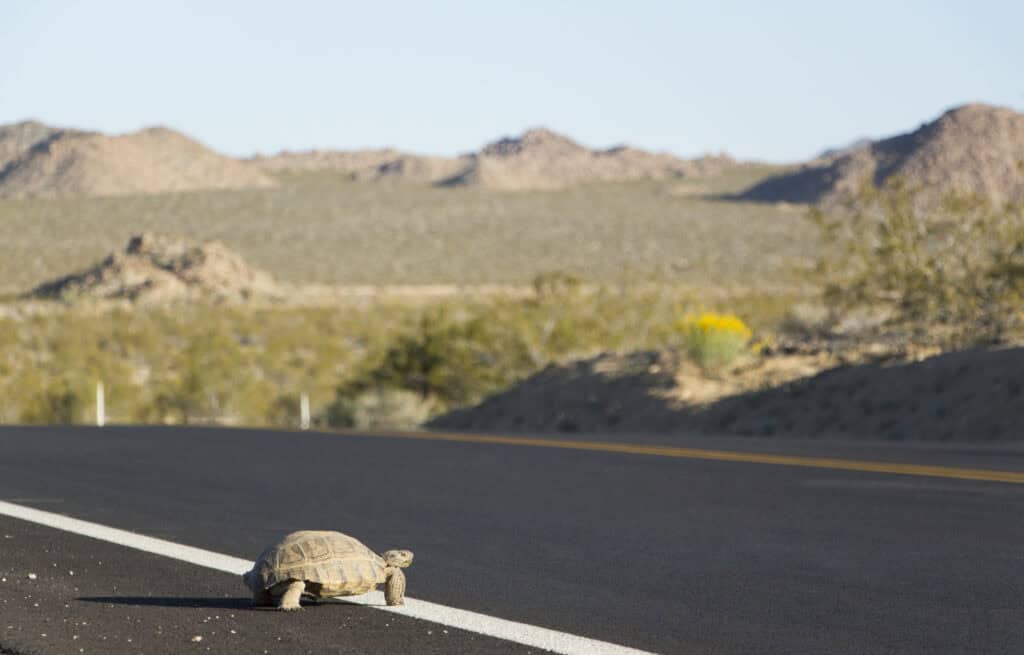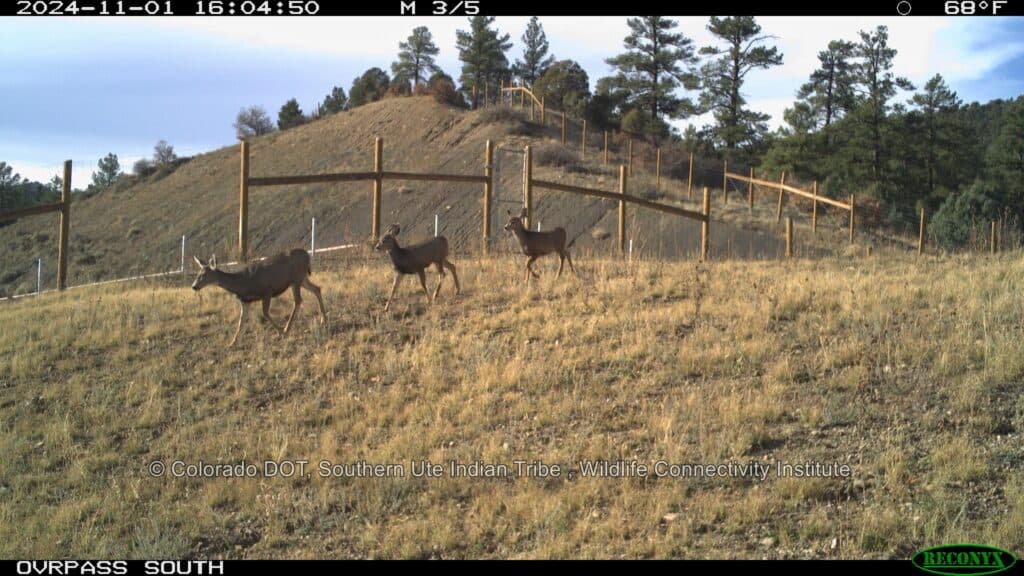The Wildlife Society and a coalition of nongovernmental organizations are calling for federal investment in programs to improve wildlife crossings—reducing vehicle damage and saving the lives of both humans and wildlife species.
“Imagine if you wake up in the morning, and someone’s put a highway between you and your kitchen,” said TWS member Patricia Cramer, an independent transportation ecology researcher and founder of the Wildlife Connectivity Institute. In this scenario, you have to cross two lanes of traffic to get breakfast and then cross another four lanes to get your kids to school before making the journey back home at night. “That’s what we’ve done to wildlife.”
The Wildlife Crossings Pilot Program, a part of the Surface Transportation Reauthorization Bill that comes every five years, was the result of a decade-long collaborative effort between a broad coalition of stakeholder groups, including TWS, the Theodore Roosevelt Conservation Partnership and many other collaborators. The legislation set aside $350 million in funds, which came from federal fuel excise taxes, to be disbursed to states via a grant application process.

As Congress crafts the next Highway Bill, the coalition is asking for at least $500 million for the Wildlife Crossings Program, as the demand for funds has more than tripled. All of the $350 million allotted for the pilot program could have been disbursed during the first round of funding. The demand for funds in the 2022-2023 application cycle was five times higher than available funding.
There are over four million miles of roads across the United States that slice through the home ranges of countless animals. Whether it’s a pronghorn (Antilocarpa americana) along a migration route or a spotted salamander (Ambystoma maculatum) heading to a breeding pond, the urge to cross a busy roadway is strong. “The imperative is so important that they’re willing to risk their lives,” Cramer said. And many animals do lose their lives—every day, an estimated 1 million native vertebrates are killed on roadways.

Beyond danger to wildlife, there’s a high financial and human cost, too. The 345,000 annual wildlife-vehicle collisions (WVCs) cause 200 deaths and 26,000 injuries, costing Americans around $11 billion, according to a report sponsored by the Nevada Department of Transportation. But that’s just reported crashes. Studies of roadkill from Utah to Virginia have shown that the number of roadkill vastly outnumbers the number of reported crashes. “Lack of reporting is a major problem,” Cramer said. If collisions go unreported, it’s more challenging for biologists and planners to identify collision hot spots and good candidates for intervention. It can even be a challenge for state transportation departments to elevate WVCs to an actionable level on the priority list if collisions are underreported.
Saving wildlife, saving people
Wildlife overpasses, underpasses, fencing and refurbished culverts are all infrastructure that can help reduce WVCs and save both wildlife and human lives. Installing crossing structures and fencing can reduce crashes by up to 97%, said TWS member Renee Calahan of Animal Road Crossings (ARC) Solutions, a nonprofit think tank that works with state, federal and Tribal partners as well as nongovernmental organizations.
“There’s proven effectiveness in reducing human and wildlife mortality, but also in allowing wildlife to move across highways in order to meet daily, seasonal and lifetime needs,” Calahan said.

Though this may seem like a lot of money, advocates say that the initial investment is well worth it. “Paying for crossing structures would cost taxpayers less than if you do nothing,” Calahan said. When migrating pronghorn were creating a public safety risk to travelers on U.S. 191 in Trappers Point, Wyoming, the state built two overpasses and five underpasses. The project, which was completed in 2012, cost a total of $12 million. The Wyoming Department of Transportation engineers estimated that the structures, which are predicted to last 75 years, will pay for themselves in just 17 years.
“The money we have from the pilot program—$350 million—is decimal dust,” Cramer said. “As biologists, we think it’s a lot of money,” she said. But in reality, it’s less than 0.1% of the Transportation Act budget. “It’s a small amount that we’re asking for to save human lives and wildlife lives,” she said.
Including wildlife in the planning process
While wildlife has been included in transportation acts for the last few decades, it has rarely been the stand-alone reason to fund transportation projects—until now.
“Historically, there hasn’t been money set aside for wildlife crossings, so you needed to be creative in how you were going to fund them,” said Sarah Barnum, chair of TWS’ Transportation Ecology Working Group. One way is through the replacement of the country’s tens of thousands of bridges and culverts that are more than 50 years old. “Upgrading old culverts and bridges is a key opportunity to add both wildlife crossings and climate resiliency,” she said.
In the eastern U.S., where waterways crisscross the landscape, culverts help water pass safely under roads—and when designed properly, can double as wildlife crossings. The West, which is characterized by larger herds of animals migrating in predictable patterns, less dense communities and fewer waterways, is a different story. Larger-scale projects, like wildlife overpasses, can be beneficial in western states like California or Colorado. The Wildlife Crossings Pilot Program (WCPP) provides critical funds to such projects, many of which faced existential financial barriers. “[The WCPP] gives you the freedom to construct projects that are focused on wildlife and to upsize a lot of existing projects, where the only reason for that upsizing is to benefit wildlife,” Cramer said.
The WCPP also includes funding for the creation of transportation plans and to determine where these structures can be most effective. Barnum is working on one such plan for the Massachusetts Department of Transportation to identify rare species, prime habitat and collision hot spots to find where wildlife crossing infrastructure would be the most valuable. The State Wildlife Transportation and Action Plan they’re working on instructs them to put wildlife crossings in places where they’re most needed. “At least a dozen studies looking at these top areas have been funded by the program,” Cramer said. Missouri, Michigan, Pennsylvania, New Mexico and other states have created their own action plans, some with the help of the WCPP. “The WCPP institutionalizes processes that will guarantee wildlife are considered in transportation going forward,” she said.
A broad coalition
WCPP funds are available not just to states but to Tribes as well. The Confederated Salish Kootenai Tribes received $8.6 million during the first round of grant disbursements in 2022-2023 to construct wildlife overpasses over U.S. Highway 93 in Ninepipe National Wildlife Management Area in Montana. The overpasses will help reduce collisions between grizzly bears (Ursus arctos horribilis) and vehicles along the highway as well as improve habitat connectivity.
Barnum sees the WCPP as an issue of rural equity as well. Urban areas tend to be the focus of federal resources and policy initiatives, leaving out many rural communities. “People in rural areas are heard, seen and noticed through legislation like this,” she said. “Rural populations are smaller, but they have the highest chance of hitting an elk and dying,” she said. “Someone cared enough to send millions of dollars so that we would be safer.”
Casey Stemler, a TWS member who was the senior advisor to the director of western states for the U.S. Fish and Wildlife Service, is now a freelance wildlife and policy consultant with his firm Spectrum Outdoors. Stemler said that the WCPP has sparked states to match funding for wildlife crossing programs. New Mexico just set aside $50 million for wildlife crossings, the greatest amount of money any single state has allocated for this kind of infrastructure. He also said that other planned projects lack key funding to proceed. “Overwhelmingly, the demand way outstretched the funding,” he said. “This isn’t a political issue,” he continued, “it’s brought together a broad coalition of people across the board.”
Calahan agrees, saying that collisions could affect anybody. “It’s not a question of if, but when, one of your loved ones is going to be affected,” she said. “If you care about safety, there are proven solutions that can be implemented today.”






